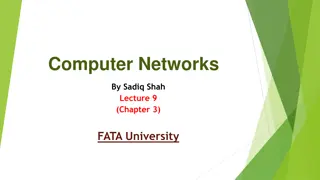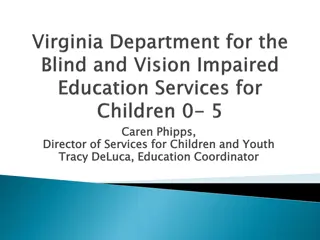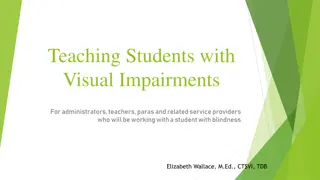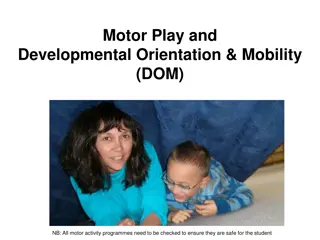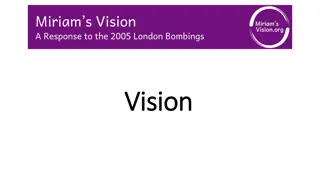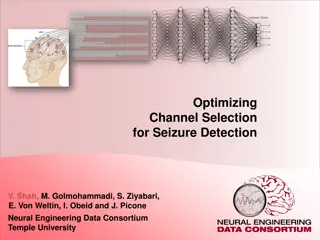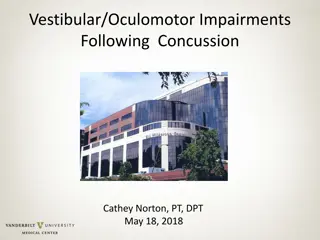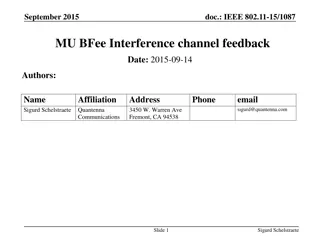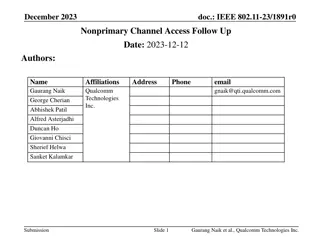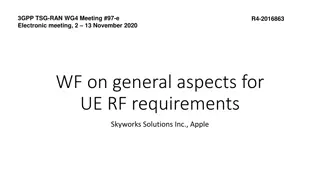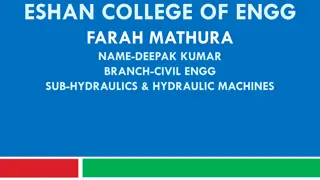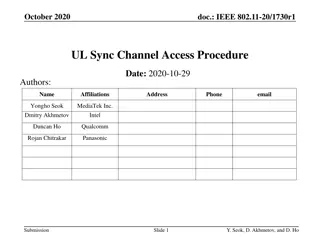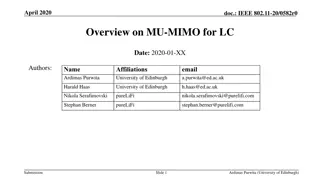Channel Design
Channel design involves creating a plan for the efficient distribution and movement of products and services from the producer to the customer. This process includes determining the channel flow, identifying channel members, setting channel objectives, and developing a channel strategy.
0 views • 13 slides
Digital Access Advisor
Explore scenarios across education and work transitions focusing on individuals facing various accessibility challenges like Autism, hearing impairments, motor impairments, dyslexia, and more. Navigate through scenarios encompassing online learning, job readiness, personal agency, and inclusive desi
0 views • 9 slides
Sales Leadership Management
Marketing channel decisions play a crucial role in the success or failure of products in both B2C and B2B markets. This chapter explores the importance of effective channel management, types of channels, the role of intermediaries in streamlining transactions, and the distinction between marketing c
1 views • 18 slides
Understanding Channel Design in Marketing
Channel design involves planning the distribution of products and services from producers to customers through different business entities or individuals. It encompasses elements like channel flow, channel members, objectives, alternatives, and strategy. Successful channel design aligns with busines
0 views • 13 slides
ML-Aided Channel Classification for WLAN Optimization
The paper discusses using machine learning to classify IEEE channel models and improve WLAN performance. It demonstrates how neural networks can accurately classify channel types, leading to efficient beamforming and signal processing. Simulation results show the classification performance even at l
0 views • 12 slides
The Importance of Primary Eye Health Care: Challenges and Solutions
Primary eye health care is crucial due to the high number of people worldwide suffering from vision impairments, with a significant portion being avoidable. This webinar by Clare Gilbert sheds light on the need for improved eye health services, covering various eye conditions and the interventions r
0 views • 11 slides
Understanding Transmission Impairments in Computer Networks
Signals traveling through transmission media in computer networks can experience attenuation, distortion, and noise, leading to signal loss and changes in form or shape. Attenuation results in energy loss requiring amplification, while distortion alters the signal's composition. Engineers use decibe
1 views • 12 slides
Successful Channel Modification Techniques and Benefits
Channel modification projects aim to accelerate the recovery of stable, sustainable channel forms in dynamic balance with sediment, large wood, and flow regimes. Successful modifications lead to improved habitat quality, stability, and diversity, benefiting sediment transport and riparian zones. Phy
0 views • 15 slides
Education Coordination Services for Children with Visual Impairments
The Education Services program by DBVI offers support to children with visual impairments, striving to assist over 2,312 youth aged 0-22, with 339 of them between birth and 5 years old. Education Coordinators conduct assessments like Functional Vision and Learning Media Assessments to enhance childr
1 views • 10 slides
Effective Channel Management Decisions for Marketing Success
The success of marketing channels lies in making right channel design decisions and effectively implementing them through channel management decisions. From selecting channel members to training and motivating them, companies must focus on building strong partnerships to drive success in the competi
5 views • 6 slides
Understanding Channel Conflict in Marketing
Channel conflict in marketing refers to disputes between different channel partners, such as manufacturers, wholesalers, and retailers, that impact business operations and goals. These conflicts can arise at different levels within the distribution channel, leading to issues like price wars, custome
0 views • 7 slides
Understanding Visual Impairments and Visual Skills in Students
Exploring the world of visual impairments, this resource delves into how individuals with blindness use their vision, the importance of visual acuity and field, and visual motor abilities. From driving to playing sports, the use of vision is crucial, with visual acuity determining clarity of sight a
3 views • 23 slides
Adapting the 802.11be Channel Model for Modern Doppler Use-Cases
The document discusses the adaptation of the 802.11be channel model to modern scenarios where devices are mobile. It explores the impact of movement on channel models, providing lab measurement results of Doppler Power Spectral Density. The study aims to enhance the evaluation of communication schem
0 views • 16 slides
The THz Channel Model in Wireless Data Center
This contribution presents preliminary THz channel modeling results for future wireless data center scenarios. Ray tracing simulations are conducted for various channel types, utilizing RMS delay spread and RMS angular spread to measure multipath richness. A stochastic channel model is developed and
0 views • 33 slides
Enhancing Development Through Sensory and Motor Play
Motor play and developmental orientation are essential for children, especially those with vision impairments. Encouraging movement and play helps in developing confidence, purpose, and motor skills. Activities like bouncing, crawling, and climbing aid in brain organization, spatial awareness, and e
1 views • 24 slides
PDSCH Demodulation Parameters & Requirements Discussion
This document covers the discussion on PDSCH demodulation parameters and requirements for UE demodulation and CSI reporting in FR2 DL 256QAM, specifically focusing on static channel mode, TDL-D channel mode, and TDL-A channel mode. The document also explores rank options, channel bandwidth, PRB allo
0 views • 9 slides
IEEE 802.11-24/0858r0: Key Concepts on NPCA and Virtual APs
This document discusses key concepts related to NPCA (Neighbor-Primary Channel Announcement) and Virtual Access Points (APs) in the context of IEEE 802.11 standards. It covers topics such as multiple BSSID sets, co-hosted APs, NPCA primary channel configurations, and criteria for channel switching.
0 views • 9 slides
802.11aj 45 GHz Channel Access and BSS Operation Framework Proposal
This document outlines a proposal for channel operation and BSS operation in the 45 GHz frequency bands for 802.11aj in China. It includes details on channelization, spectrum allocation, maximum transmit power, and BSS configuration rules. The aim is to meet the functional requirements specified whi
0 views • 32 slides
Understanding Vision and Visual Impairment
From the definitions of vision to eye facts and insights on visual impairment, this comprehensive content delves into the intricacies of sight, covering the anatomy of the eye, how vision works, and the impact of visual impairments. Explore the wonders of eyesight and learn about the challenges face
0 views • 21 slides
Longitudinal Study on Transitions for Students with Visual Impairments
This presentation delves into the longitudinal study focusing on transitions for students with visual impairments conducted by VICTAR at the University of Birmingham. Covering aspects such as equipping young individuals with visual impairments to access information independently and their experience
0 views • 40 slides
Prioritizing the Lahontan Region 303(d) List Overview
This presentation discusses the 303(d) list for the Lahontan region, addressing impairments in surface waters that do not meet water quality objectives. It covers updates, prioritization strategies, and different impairment categories. The presentation also delves into the implications and actions r
0 views • 12 slides
Further Considerations on Advanced Channel Coding for 15.4ab
This document submitted to the IEEE P802.15 Working Group discusses the importance of advanced channel coding for IEEE 802.15.4ab standard to achieve higher throughput and reliability. It outlines technical guidance on proposed solutions, safeguards, interference mitigation techniques, and backward
0 views • 14 slides
Gender-based Violence Experiences Among Women with Physical Impairments in Tshwane Metro, Pretoria
This study explores the gender-based violence experiences of women with physical impairments in Tshwane Metro, Pretoria. It aims to identify risk and protective factors, recommend multi-disciplinary collaborations for GBV initiatives, and sheds light on the underrepresentation of women with disabili
0 views • 19 slides
Proposal for Improved Channel Access Efficiency in IEEE 802.11 Networks
The proposal addresses the inefficiencies in utilizing secondary channels in IEEE 802.11 networks, aiming to enhance access to wideband channels (>20 MHz) when the primary channel is busy. It introduces a mechanism for APs and STAs to access available secondary channels while the primary channel is
0 views • 7 slides
IEEE 802.11-24/0070r1 Presentation on Non-Primary Channel Access
This presentation discusses the concept of using secondary channels for PPDU transmission in IEEE 802.11 networks to improve efficiency in large bandwidth scenarios. It covers topics such as channel access, backoff mechanisms, and channel switching thresholds. Design principles emphasize minimal imp
0 views • 15 slides
Proposed MAP Channel Access Procedures in IEEE 802.11-24/72r0
In the May 2024 document IEEE 802.11-24/72r0, a uniform MAP coordination framework is discussed, involving procedures like M-AP discovery, coordinated transmissions, and channel access mechanisms. All APs in a coordination group can compete for channel access and share transmission opportunities. Th
0 views • 10 slides
Optimizing Channel Selection for Seizure Detection with Deep Learning Algorithm
Investigating the impact of different channel configurations in detecting artifacts in scalp EEG records for seizure detection. A deep learning algorithm, CNN/LSTM, was employed on various channel setups to minimize loss of spatial information. Results show sensitivities between 33%-37% with false a
0 views • 12 slides
Enhanced Distributed Channel Access (EDCA) for Non-Primary Channel in IEEE 802.11
Discussion on implementing EDCA for Non-Primary Channel Access (NPCA) in IEEE 802.11, focusing on mitigating frame collisions and enhancing medium efficiency. Various considerations for EDCA procedure on the Non-Primary Channel (NPCH) are explored to optimize channel access and reduce wastage. Topic
0 views • 13 slides
IEEE 802.11-23/1935r0 - Secondary Channel Usage Discussions
Explore the discussions on secondary channel usage in IEEE 802.11-23/1935r0, including topics like RU index, BW negotiation, avoiding medium synchronization loss, and single/multiple secondary backoff 20MHz channels. Discover insights on non-primary backoff 20MHz channel locations, transitioning del
0 views • 15 slides
Dynamic Channel Switch Operation in IEEE 802.11-24 Standard
STAs in IEEE 802.11-24 can dynamically switch to secondary channels per the AP's request for frame exchanges. The process involves soliciting control frames, determining parking channels, managing frame exchanges, and switching back to the primary channel at the end of a TXOP. Various examples illus
1 views • 11 slides
Channel Generation Process for IEEE 802.11aj (45GHz) Based on Channel Measurement
This presentation by Haiming Wang and team from SEU/CWPAN discusses the process of channel realization and generation in the 45 GHz bandwidth. It covers the generation of the channel impulse response, modeling of parameters, statistical measurements, and future work related to the 802.11ad standard.
0 views • 27 slides
Understanding Vestibular and Oculomotor Impairments Post-Concussion
This presentation discusses common vestibular and oculomotor impairments following a concussion, highlighting the importance of the Vestibular/Ocular Motor Screening Assessment in identifying and monitoring concussions. It covers evaluation techniques for the vestibular system, interventions for ocu
0 views • 69 slides
Understanding Impairments in Wireline Communication Channels
Wireline communication channels can experience various impairments such as linear time-invariant effects like attenuation and spreading, as well as linear time-varying effects like phase jitter, nonlinear effects, additive noise, and interference. These impairments can affect the quality of transmit
0 views • 16 slides
IEEE 802.11-15/0364: Channel Estimation Considerations in Wi-Fi Standards
Channel estimation in IEEE 802.11 standards, such as 11n, 11ac, and 11ax, is crucial for efficient MIMO systems. The noise impact during data reception affects the quality of the channel estimate, leading to SNR reduction post-equalizer. Techniques like channel smoothing and averaging of training se
0 views • 11 slides
Managing Channel Information for Wireless Communication Systems
This document from September 2015 discusses issues related to updating channel information in wireless communication systems, focusing on MU-MIMO and TxBF precoding techniques. It explains the challenges of channel aging, the importance of refreshing channel information, and the impact of different
0 views • 16 slides
Enhancing Spectral Efficiency Through Nonprimary Channel Access in IEEE 802.11
IEEE 802.11 is exploring nonprimary channel access to address underutilization of spectrum and improve latency and throughput. This approach involves enabling nonprimary channel access with simple modifications to existing rules, such as limiting TXOP duration and using control frames for coordinati
0 views • 13 slides
Overview of UE RF Requirements for 35/45MHz Channel Bandwidth in 3GPP Meeting #97-e
The document discusses the introduction of 35/45MHz channel bandwidth in UE RF requirements for various bands. It covers equation-based requirements and limitations in UL configurations based on bandwidth allocation. The scope includes capturing content from the first round discussions and clarifyin
0 views • 16 slides
Understanding Open Channel Hydraulics: Types of Channels, Flows, and More
Gain insights into open channel hydraulics covering topics like types of channels, various flows, velocity distribution, discharge mechanisms, and economical channel sections. Delve deeper into specific energy, hydraulic jump, gradually varied flow, and the distinction between steady/unsteady and un
0 views • 11 slides
UL Sync Channel Access Procedure in IEEE 802.11-20/1730r1
The document discusses the UL sync channel access procedure in IEEE 802.11, focusing on the conditions under which an STA affiliated with an MLD can initiate transmission, manage its backoff counter, and follow specific rules for accessing the channel. It proposes a straw poll to gather support for
0 views • 8 slides
Overview of MU-MIMO Challenges and Solutions for Light Communications
This presentation by Ardimas Purwita from the University of Edinburgh delves into the challenges faced in implementing MU-MIMO for light communications (LC) and offers potential solutions. It discusses issues such as highly-correlated channel gain matrices, varying delay of channel impulse responses
0 views • 11 slides






